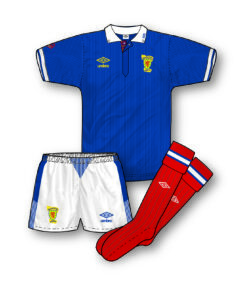 Scotland fans are passionate about the national team kits. For some, it’s the glorious diamond-taped extravaganza of the late 1970s and early 1980s that is the pinnacle of Scottish team strips; others plump for the purple tartan of Euro 96 (despite the grim memories it generates). For me though, it’s the beautiful 1988-91 home ensemble that is the best Scotland strip of all time and actually, with a gun to my head, I’d say it’s probably my all-time favourite kit of any team… ever.
Scotland fans are passionate about the national team kits. For some, it’s the glorious diamond-taped extravaganza of the late 1970s and early 1980s that is the pinnacle of Scottish team strips; others plump for the purple tartan of Euro 96 (despite the grim memories it generates). For me though, it’s the beautiful 1988-91 home ensemble that is the best Scotland strip of all time and actually, with a gun to my head, I’d say it’s probably my all-time favourite kit of any team… ever.
The shirt appeared as a retro-influenced kit theme began to appear throughout the British game – a trend that replaced the ‘progressive modernist’ approach to football fashion that had occurred throughout the 1980s. That was a decade dominated by trim v-necks, wrapover crew necks and contemporary sartorial flourishes, including the infamous ‘horror-zontal’ navy band that had been included on the previous Scotland strip. This new ‘post-modern’ approach to football kit design was subsequently to lead throughout the 1990s.
The kit was first worn in May 1988 in a Rous Cup 0–0 draw with Colombia and introduced an era of button-down collars, generally accompanied by a placket or button opening in the neck. Press-stud button-down collars were to find their way on to virtually every Umbro shirt over the next three or four years and were rapidly copied by many other smaller sportswear brands at the time.
The placket on this shirt was unique however, in that it was VERY long, reaching down to beyond the team crest and Umbro logo, and really brought to mind the old-fashioned shirts of the 1940s and 50s. Plus, in a real stylistic triumph, it incorporated a subtle tartan design, the first time this most famous icon of Scottish visual identity had been included in the national side’s kit. The tartan itself was a unique blend, specially designed for the Scottish Football Association. It was a brave move and perhaps one only made possible by the seismic shift in kit design thinking that occurred at the end of the 1980s.
The rest of the shirt was full of delicate design elements that all contributed to making it a real classic. With longer than usual sleeves, it was more generously cut than the previous Scottish jersey, therefore making it more appealing to the more bulky replica-wearing Tartan Army foot soldiers and the fabric featured a subtle shadow pinstripe that added class to the entire ensemble. Finally, two small Scottish Football Association icons were added, a Gothic monogram on the collar that had made its first appearance on the previous outfit and a more complex crest-like design on the right sleeve.
Another aspect that is often ignored with this shirt, but one that I believe helps lift it out of the ordinary, was the inclusion of a yellow Umbro logo rather than the more familiar white version, which complemented perfectly the new SFA crest that was introduced on this outfit. The new crest with its flamboyant scrolls embracing the lion rampant shield, replaced the popular but rather bulky roundel badge that had been favoured for the past 20 years and more. All of these elements, small as they may be, were clearly highly considered by the Umbro team and combined exquisitely on this outfit. White shorts with a pinstriped diamond motif in the centre and navy trim were accompanied by the familiar red socks that now also included navy and white bands and an Umbro logo.
The strip was first choice throughout Italia 90 and made its debut in the tournament in the 2–1 win over Sweden following the disaster against Costa Rica – a match in which Scotland sported their away kit, prompting Andy Roxburgh to comment after the game that at least for the forthcoming clashes against Sweden and Brazil his team would be wearing their home strip which he always preferred seeing Scotland wear, knowing how much the navy blue meant to his team.
The likes of Mo Johnston, Paul McStay, Ally McCoist, Brian Fleck, Stuart McCall, Dave McPherson and Gordon Durie were amongst the players who sported the kit in action. Its last outing was in a 1–0 friendly defeat against the USSR in February 1991. The first team had worn it 19 times in total, winning eight (including notable victories against France and Argentina), drawing five and losing six. But whatever the result on the pitch, the Scotland team always looked magnificent in this kit.
I adored the 1988–91 shirt – I actually ended up with two replica versions – and wore it regularly in weekly five-a-side matches for years. Everything about it seemed right, from the timeless fit and elegant collar through to the patriotic tartan and sophisticated shadow pinstripe: Scottish kit perfection.


